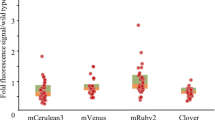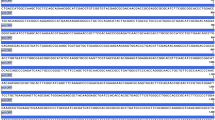Abstract
In the present study, we established a genetic system for manipulating the oleaginous heterotrophic microalgae Aurantiochytrium sp. KRS101, using cycloheximide resistance as the selectable marker. The gene encoding ribosomal protein L44 (RPL44) of Aurantiochytrium sp. KRS101 was first identified and characterized. Proline 56 was replaced with glutamine, affording cycloheximide resistance to strains encoding the mutant protein. This resistance served as a novel selection marker. The gene encoding the Δ12-fatty acid desaturase of Mortierella alpina, used as a reporter, was successfully introduced into chromosomal DNA of Aurantiochytrium sp. KRS101 via 18S rDNA-targeted homologous recombination. Enzymatic conversion of oleic acid (C18:1) to linoleic acid (C18:2) was detected in transformants but not in the wild-type strain.




Similar content being viewed by others
References
Biondo PD, Brindley DN, Sawyer MB, Field CJ (2008) The potential for treatment with dietary long-chain polyunsaturated n-3 fatty acids during chemotherapy. J Nutr Biochem 19:787–796
von Schacky C, Harris WS (2007) Cardiovascular benefits of omega-3 fatty acids. Cardiovasc Res 73:310–315
Lee JH, O’Keefe JH, Lavie CJ, Harris WS (2009) Omega-3 fatty acid: cardiovascular benefits, sources and sustainability. Nat Rev Cardiol 6:753–758
Bongiorni L, Jain R, Raghukumar S, Aggarwal RK (2005) Thraustochytrium gaertnerium sp. nov.: a new thraustochytrid stramenopilan protest from mangroves of Goa, India. Protist 156:303–315
Burja AM, Radianingtyas H, Windust A, Barrow CJ (2006) Isolation and characterization of polyunsaturated fatty acid producing Thraustochytrium species: screening of strains and optimization of omega-3 production. Appl Microbiol Biotechnol 72:1161–1169
Conquer JA, Holub BJ (1996) Supplementation with an algae source of docosahexaenoic acid increases (n-3) fatty acid status and alters selected risk factors for heart disease in vegetarian subjects. J Nutr 126:3032–3039
Warude D, Joshi K, Harsulkar A (2006) Polyunsaturated fatty acids: biotechnology. Crit Rev Biotechnol 26:83–93
Qiu X (2003) Biosynthesis of docosahexaenoic acid (DHA, 22:6–4,7,10, 13,16,19): two distinct pathways. Prostag Leukotr Ess 68:181–186
Gill I, Valivety R (1997) Polyunsaturated fatty acids, part 1: occurrence, biological activities and applications. Trends Biotechnol 15:401–409
Innis SM (1991) Essential fatty acids in growth and development. Prog Lipid Res 30:39–103
Metz JG, Roessler P, Facciotti D, Levering C, Dittrich F, Lassner M, Valentine R, Lardizabal K, Domergue F, Yamada A, Yazawa K, Knauf V, Browse J (2001) Production of polyunsaturated fatty acids by polyketide synthases in both prokaryotes and eukaryotes. Science 293:290–293
Okuyama H, Orikasa Y, Nishida T, Watanabe K, Morita N (2007) Bacterial genes responsible for the biosynthesis of eicosapentaenoic and docosahexaenoic acids and their heterologous expression. Appl Environ Microbiol 73:665–670
Cheng RB, Lin XJ, Wang ZK, Yang SJ, Rong H, Ma Y (2011) Establishment of a transgene expression system for the marine microalgae Schizochytrium by 18S rDNA-targeted homologous recombination. World J Microbiol Biotechnol 7:737–741
Sakaguchi K, Matsuda T, Kobayashi T, Ohara J, Hamaguchi R, Abe E, Nagano N, Hayashi M, Ueda M, Honda D, Okita Y, Taoka Y, Sugimoto S, Okino N, Ito M (2012) Versatile transformation system that is applicable to both multiple transgene expression and gene targeting for Thraustochytrids. Appl Environ Microbiol 78:3193–3202
Hong WK, Rairakhwada D, Seo PS, Park SY, Hur BK, Kim CH, Seo JW (2011) Production of lipids containing high levels of docosahexaenoic acid by a newly isolated microalgae, Aurantiochytrium sp. KRS101. Appl Biochem Biotechnol 164:1468–1480
Hong WK, Kim CH, Heo SY, Luo LH, Oh BR, Rairakhwada D, Seo JW (2011) 1,3-Propandiol production by engineered Hansenula polymorpha expressing dha genes from Klebsiella pneumonia. Bioprocess Biosyst Eng 34:231–236
Cheng RB, Lin XZ, Wang ZK, Yang SJ, Rong H, Ma H (2011) Establishment of a transgene expression system for the marine microalgae Schizochytrium by 18S rDNA-targeted homologous recombination. World J Microbiol Biotechnol 27:737–741
Lewis T, Nichols PD, McMeekin TA (2000) Evaluation of extraction methods for recovery of fatty acids from lipid-producing microheterotrophs. J Microbiol Methods 43:107–116
Kim IG, Nam SK, Sohn JH, Rhee SK, AN GH, Lee SH, Choi ES (1998) Cloning of the ribosomal protein L41 gene of Phaffia rhodozyma and its use a drug resistance marker for transformation. Appl Environ Microbiol 64:1947–1949
Kondo K, Saito T, Kajiwara S, Takagi M, Misawa N (1995) A transformation system for the yeast Candida utilis: use of a modified endogenous ribosomal protein gene as a drug-resistant marker and ribosomal DNA as an integration target for vector DNA. J Bacteriol 177:7171–7177
Herschleb J, Ananiev G, Schwartz DC (2007) Pulsed-field gel electrophoresis. Nat Protoc 2:677–684
Acknowledgments
This work was supported the Advanced Biomass R&D Center of Korea (Grant No. 2010-0029737) funded by the Ministry of Education, Science and Technology and by the Ministry of Food, Agriculture, Forestry, and Fisheries, of the Republic Korea.
Author information
Authors and Affiliations
Corresponding authors
Additional information
A. Kondo and J.-W. Seo are co-corresponding authors.
Electronic supplementary material
Below is the link to the electronic supplementary material.
449_2012_846_MOESM1_ESM.ppt
Supplementary Fig. 1. GC–MS of fatty acids (FAMEs) extracted from freeze-dried cells of a transformant of Aurantiochytrium sp. KRS101. The cells were cultured in 0.15-0.2 mM CYH containing medium at 28 °C for 3 days, and then cultured for an additional 1 day after addition of 0.1 mM OA. (A) FAMEs from transformant corresponding to the OA methyl ester; (B) OA methyl ester standard; (C) FAMEs from transformant corresponding to the LA methyl ester; (D) LA methyl ester standard. The standards of OA methyl ester and LA methyl ester, which were also analyzed, were Sigma-Aldrich commercial products (Sigma-Aldrich, MO, USA). (PPT 302 kb)
Rights and permissions
About this article
Cite this article
Hong, WK., Heo, SY., Oh, BR. et al. A transgene expression system for the marine microalgae Aurantiochytrium sp. KRS101 using a mutant allele of the gene encoding ribosomal protein L44 as a selectable transformation marker for cycloheximide resistance. Bioprocess Biosyst Eng 36, 1191–1197 (2013). https://doi.org/10.1007/s00449-012-0846-6
Received:
Accepted:
Published:
Issue Date:
DOI: https://doi.org/10.1007/s00449-012-0846-6




